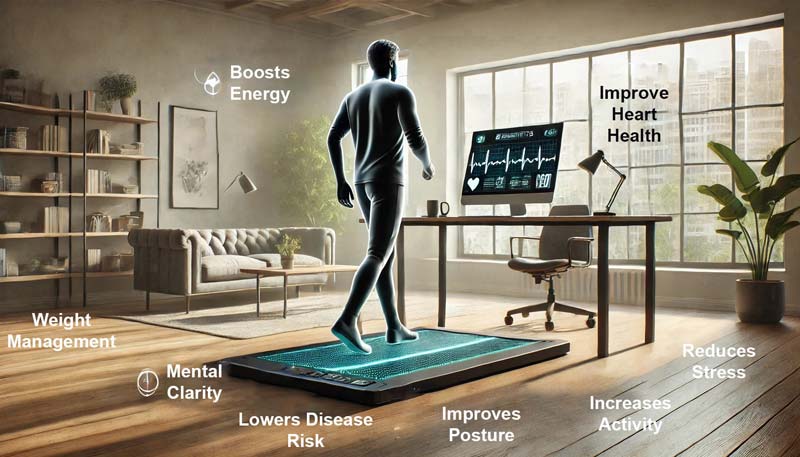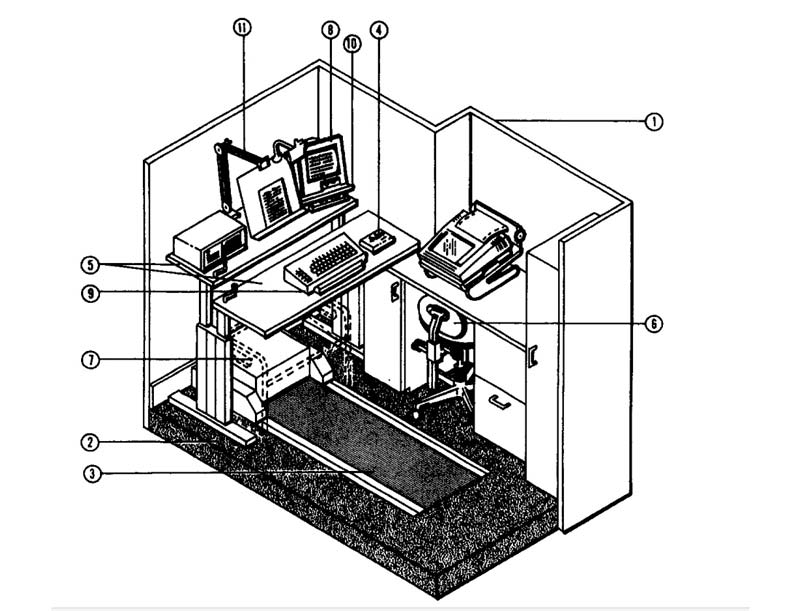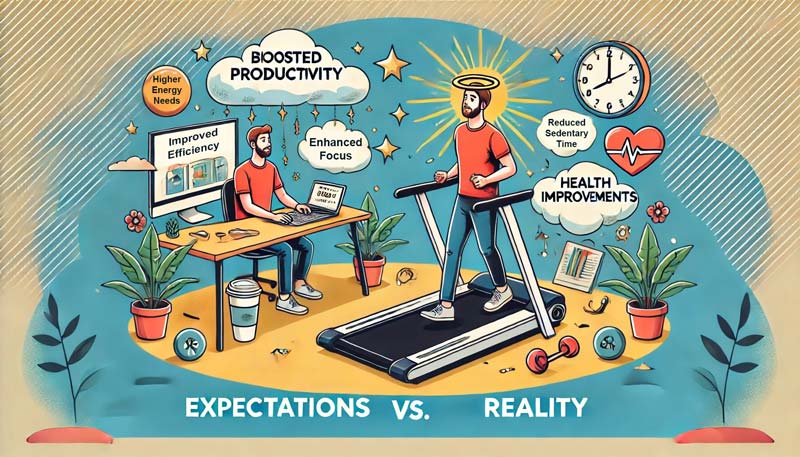Walking pads and treadmill desks have emerged as innovative solutions to combat the increasingly sedentary nature of modern lifestyles. As someone interested in health and fitness, I’ve observed a growing interest in these devices, mainly since recent global events accelerated changes in work and lifestyle patterns.
This trend reflects a broader awareness of the health risks associated with prolonged sitting and the need for creative approaches to incorporate movement into our daily routines.
The concept of combining daily tasks with physical activity has been introduced previously. In fact, the idea of treadmill desks in office settings dates back to the late 1980s. However, the COVID-19 pandemic and lockdown have brought renewed attention to maintaining physical activity. This has led to developing and popularising more compact and versatile walking pads.
In my experience, I’ve noticed a significant uptick in interest in home-based fitness solutions, including walking pads. This aligns with research showing that 65% of treadmill desk users obtained their devices in 2020 or 2023.
This surge in adoption speaks to a growing recognition of the need to counteract sedentary behaviour, whether at home, in the office, or as part of a fitness routine.
Walking pads and treadmill desks offer a unique approach to this challenge. They allow users to walk at low speeds while continuing their everyday activities, effectively turning traditionally sedentary tasks into opportunities for light physical activity. As someone who’s always emphasised the importance of movement throughout the day, I find this integration of exercise and daily routines particularly intriguing.
However, it’s crucial to approach these devices with a critical eye. While they show promise in increasing daily step counts and reducing sedentary time, their effectiveness and impact on various activities are areas that warrant closer examination. The following sections go deeper into the potential benefits, limitations, and practical considerations of using walking pads and treadmill desks.
We’ll explore the evolution of these devices, from workplace solutions to versatile fitness tools, examine the scientific evidence behind their effectiveness, and discuss their potential impact on modern lifestyles.
Whether you’re considering incorporating a walking pad into your home, office, or fitness routine or simply curious about innovative approaches to staying active, this comprehensive analysis provides the insights needed to make informed decisions about your health and productivity.
Understanding Walking Pads and Treadmill Desks
Walking pads and treadmill desks represent an innovative approach to combating sedentary behaviour in our daily lives. As a fitness professional, I’ve seen various trends come and go. Still, these devices have caught my attention for their unique functionality and health benefits.
What exactly are walking pads and treadmill desks?
- Definition: Treadmill desks are vertical workstations with a motorised platform featuring a continuous belt that allows users to walk while working.
- Speed: They typically operate between 0.5 and 2.5 mph, with 1.5 mph being an expected speed used in research studies.
- Design: Unlike traditional treadmills, these devices are optimised for low-speed walking while working rather than for high-intensity exercise.
Key Features:
- Integrated Workstation: Many models combine a treadmill base with a standing desk, creating a comprehensive active workspace.
- Speed Control: Users can adjust their walking speed, with reported ranges from 0.7 to 3 mph.
- Versatility: These devices can be used for various tasks, including meetings, video conferences, reading, writing, and leisure activities like watching TV.
Walking pads and treadmill desks fall under the broader category of active workstations, which aim to interrupt prolonged sitting periods. This category also includes:
- Sit-stand desks
- Stepping devices
- Pedal machines
The Evolution of Treadmill Desks
Interestingly, the concept of treadmill desks has expanded beyond the traditional office setting. With the rise of remote work, these devices have found their way into home environments, serving dual purposes:
- Home Office Solution: Enabling work-from-home individuals to stay active during work hours.
- Leisure Activity Tool: Allowing for movement during typically sedentary activities like watching television.
This versatility has been a critical factor in their growing popularity. It’s not just about work anymore – it’s about reimagining how we approach movement throughout our day.
The Shift in Workplace Wellness
Introducing walking pads and treadmill desks represents a significant shift in workplace wellness strategies. Unlike traditional interventions that focus on providing access to gyms or health clubs outside of work hours, these devices integrate physical activity directly into the workday.
This approach provides ways to incorporate movement into our daily routines rather than treating exercise as a separate, time-consuming activity.
Either way, remember that these devices are tools designed to complement, not replace, a comprehensive approach to health and fitness.

Potential Benefits of Active Movement While Stationary
Integrating walking pads and treadmill desks into our daily routines offers a range of potential benefits. Research has shed light on several key advantages:
- Increased Energy Expenditure
Studies have shown a significant increase in calorie burn when using treadmill desks:
- Users expend an additional 105.23 kcal per hour compared to sitting.
- This increased energy expenditure could contribute to weight management and overall health improvements.
- Reduction in Sedentary Time
Treadmill desk users have demonstrated a notable decrease in sitting time:
- A reduction of 1.73 minutes per hour over 24 hours compared to conventional desk users.
- This decrease in sedentary behaviour could have important implications for overall health.
- Cardiovascular Health Benefits
While more research is needed, some studies suggest positive effects on cardiovascular health:
- Trends towards improvements in cardiometabolic risk factors, including blood pressure, glucose levels, and lipid profiles.
- Potential for reducing the risk of cardiovascular disease associated with sedentary behaviour.
- Physical and Mental Well-being
Users of treadmill desks have reported numerous benefits:
- Physical improvements: Reduced joint pain, increased activity levels, and better cardiovascular fitness.
- Mental benefits: Enhanced focus, increased alertness, reduced fatigue, and improved mood.
- Workplace Satisfaction and Productivity
The use of treadmill desks has been associated with positive workplace outcomes:
- Increased job satisfaction and engagement, particularly for remote workers.
- Some users report feeling more productive and experiencing improved creativity while walking.
- Increased Daily Physical Activity
Research indicates that treadmill desk use can significantly boost daily activity levels:
- Users walk an average of 2 additional miles per day.
- In long-term studies, participants showed sustained increases in daily physical activity, primarily during work hours.
- Potential for Weight Management
While not a substitute for a comprehensive weight loss programme, treadmill desks may contribute to weight management:
- Individuals with obesity lost more weight than lean subjects when given access to treadmill desks.
- The additional calorie burn throughout the day may support overall weight management efforts.
- Improvements in Health Markers
Long-term use of treadmill desks has been associated with improvements in specific health indicators:
- Significant increases in HDL (removes excess cholesterol from the bloodstream, sometimes referred to as “good” cholesterol for this reason) cholesterol levels throughout a year-long intervention.
- Potential for mitigating risks associated with prolonged sitting, such as type II diabetes and mood disorders.
It’s important to note that while these benefits are promising, the impact of treadmill desks on complex cognitive tasks and executive functions is still a subject of ongoing research.
Effectiveness: What Research Reveals About Walking Pads and Treadmill Desks
To understand the impact of walking pads and treadmill desks, we must look beyond potential benefits and examine the complex data from scientific studies. This section probes the research methodologies and critical findings that shed light on the effectiveness of these devices.
Long-Term Studies: A Year in the Life
A groundbreaking year-long prospective trial involving 36 office workers provides valuable insights into the sustained effects of treadmill desk use:
- Activity Patterns: Daily physical activity increased from 3,353 AU/day (daily physical activity) at baseline to 4,460 AU/day at 6 months and 4,205 AU/day at 12 months.
- Work Hours Impact: Desk use accounted for 63% of increased activity at 6 months and 90% at 12 months, highlighting its effectiveness during work time.
- Individual Differences: The study revealed interindividual consistency in activity levels, suggesting that personal patterns persist even with environmental interventions.
Comparative Effectiveness
Research has also compared treadmill desks to other active workstation interventions:
- Energy Expenditure: Treadmill desks increase energy expenditure more than other active workstations.
- Physiological Benefits: They are associated with more significant physiological benefits than standing desks.
Cognitive Performance: A Complex Picture
The impact of treadmill desks on cognitive function and work performance is nuanced:
- Task-Specific Effects: Performance may vary depending on the task. For instance, fine motor skills like typing may be negatively affected.
- Intensity Matters: Low-intensity walking typical of treadmill desks may not provide sufficient arousal to enhance cognitive performance, unlike moderate-intensity exercise.
- Executive Functions: Some studies suggest that essential executive functions, such as response inhibition, remain intact during slow treadmill walking.
Professional Impact: Beyond the Numbers
Research has explored the effects of treadmill desks on professional outcomes:
- Physician Study: A study of physicians found that using a treadmill desk led to weight loss and reduced body fat compared to not using one.
- Recall and Attention: Some studies have shown improvements in recall and attention, as well as increased vigour and positive affect, without sacrificing most task performance.
These findings show the effectiveness of walking pads and treadmill desks. While they consistently show benefits in terms of physical activity and sedentary behaviour reduction. Their impact on cognitive performance and work productivity varies.

Limitations and Practical Considerations
While walking pads and treadmill desks offer numerous benefits, it’s crucial to consider their limitations and practical aspects before implementation. These devices, though innovative, may only be suitable for some individuals or work environments.
One significant limitation is the potential impact on specific work tasks. Activities requiring fine motor skills or intense concentration can be challenging while walking. For instance, some users struggle with precise mouse movements or typing accurately when using a treadmill desk. This limitation could affect productivity for tasks requiring high manual dexterity or focused attention.
Physical limitations also affect the suitability of these devices. Individuals with certain health conditions or mobility issues might find using a walking pad or treadmill desk unsafe or uncomfortable. Considering potential users’ diverse needs and capabilities is essential, especially in a workplace where accessibility is paramount.
Space requirements and noise levels are practical considerations. Walking pads and treadmill desks typically require more room than traditional desks, which could be problematic in compact office spaces. Though often minimal, these devices’ noise might be disruptive in open-plan offices or shared work environments.
Another important consideration is the cost factor. Walking pads and treadmill desks are generally more expensive than conventional desks. This initial investment could be a barrier for individuals or organisations looking to implement these devices on a large scale. However, it’s worth weighing this cost against potential long-term health benefits and productivity gains.
Adaptation time is an often overlooked factor. New users may experience a learning curve as they adjust to walking while working. This adaptation period could affect work performance, particularly in the first few months of use. Some studies suggest a minor dip in productivity during this initial phase.
The effectiveness of these devices may also decrease over time. Research indicates that the impact on physical activity tends to be more significant in the first six months of use than measurements taken after a year. This potential waning effect should be considered when evaluating the long-term benefits of implementing walking pads or treadmill desks.
Lastly, the impact on workplace dynamics and professional appearance should be considered. Some users feel self-conscious about using these devices during video calls or presentations. The visual and auditory presence of a walking pad or treadmill desk might need to align with traditional notions of workplace professionalism in specific industries or cultures.
User Experiences and Common Motivations
Adopting walking pads and treadmill desks often stems from a desire to lead a more active lifestyle. Users frequently cite health goals as their primary motivation, with many aiming to increase physical activity and reduce sedentary time in their daily routines. This motivation has become particularly pronounced as awareness of the health risks associated with prolonged sitting has grown.
Interestingly, the COVID-19 pandemic has played a significant role in driving interest in these devices. As many people transitioned to remote work, they grappled with increased sedentary behaviour. This shift prompted a search for innovative solutions to stay active while working from home.
Usage patterns vary widely among individuals. Some users incorporate walking pads into their routine for short periods each day. In contrast, others report using them for several hours, taking breaks as needed. This flexibility allows users to adapt the device to their preferences and work demands.
One common theme among users is the appreciation for the ability to multitask. Many view walking pads as an efficient way to incorporate physical activity into their busy schedules, describing it as a “two for one” opportunity. This sentiment is powerful among those juggling work and family commitments.
Motivation to continue using walking pads often comes from tangible results. Users frequently set daily step count goals or track metrics such as distance walked or calories burned. The ability to monitor progress towards these goals appears to be a significant factor in maintaining engagement. Some users also report that anticipating positive outcomes, such as pain relief or increased afternoon energy, motivates them to use their walking pads consistently.
Adaptation to using a walking pad or treadmill desk typically occurs quickly. Most users report acclimating within a few minutes, with no significant injuries or adverse events reported, even in long-term studies. This suggests these devices can be safely integrated into various environments with minimal disruption.
Individual activity patterns remain consistent even after introducing a walking pad into one’s routine. This suggests that personal habits play a vital role in determining usage patterns, highlighting the importance of individual motivation in successfully adopting these devices.
While many users report positive experiences, it’s worth noting that some challenges exist. Initial difficulties with tasks requiring fine motor skills or rapid information processing are common, particularly for new users. However, many find that the potential health benefits outweigh these temporary challenges.
Overall, user experiences with walking pads and treadmill desks are mainly positive, with many reporting improved physical and mental well-being. The key to success appears to be balancing each individual’s lifestyle and work demands.

Critical Analysis: Expectations vs. Reality of Walking Pads and Treadmill Desks
The Promise:
Walking pads and treadmill desks offer an enticing solution to our increasingly sedentary lifestyles. They promise increased physical activity, improved health, and enhanced productivity – all while we work or engage in leisure activities. But how well do these devices live up to their hype?
Energy Expenditure: A Modest Boost
- Reality Check: While users can expect an increase in energy expenditure, it’s modest – about 100 kcal per hour.
- Context Matters: This increase should be considered part of overall daily activity, not a replacement for dedicated exercise.
Health Benefits: Promising, But Not Definitive
Research suggests potential improvements in cardiometabolic risk factors, but results are only sometimes significant. Users should maintain realistic expectations about health benefits achievable through walking pad use alone.
Productivity and Cognitive Performance: A Mixed Bag
- Some users report increased productivity and job satisfaction.
- However, experimental research shows potential decreases in tasks requiring fine motor skills or rapid information processing.
- The key? Individual experiences vary, and long-term adaptation may play a role.
Weight Management: Not a Magic Solution
Walking pads can increase daily physical activity, but their impact on weight loss may be less than expected. They’re best viewed as one component of a comprehensive health strategy, not a standalone solution.
The Individuality Factor:
Personal habits and preferences significantly influence the effectiveness of walking pads. What works for one person may not suit another, highlighting the importance of individual considerations.
Comparing Alternatives:
Walking pads are just one strategy for reducing sedentary time. Other options, such as standing desks, regular walking breaks, or structured exercise programs, might suit some individuals or environments.
The Bottom Line:
Walking pads and treadmill desks can be valuable tools for increasing physical activity and reducing sedentary time. However, they’re not a panacea for all health and productivity concerns. Users should approach these devices with realistic expectations and understand their strengths and limitations.
Key Takeaways:
- Supplement, don’t replace: Use walking pads to complement, not substitute, regular exercise.
- Individualise: Consider personal needs, work requirements, and preferences when adopting a walking pad.
- Holistic approach: Integrate walking pad use into a broader strategy for health and productivity.
- Realistic expectations: Understand the modest but potentially beneficial impact on energy expenditure and health markers.
- Adaptation period: Allow time for adjustment, especially for tasks requiring fine motor skills.
Impact on Modern Lifestyles
After researching walking pads and treadmill desks, I marvelled at their potential to reshape our daily routines. These devices aren’t just another fitness trend; they respond to a growing crisis in our increasingly sedentary lives.
The numbers are staggering. Adults spend 10 to 13 hours of their waking day engaged in sedentary activities, which is a sobering reality.
Walking pads and treadmill desks offer a glimpse into a future where physical activity is seamlessly woven into our daily tasks. Imagine a workday where movement is constant, where the line between ‘work time’ and ‘exercise time’ blurs into insignificance.
But it’s not just about physical health. These devices are challenging our very notion of work-life balance. Users report a sense of accomplishment, not just in their professional tasks but also in their personal health goals. It’s a subtle shift with profound implications for how we view productivity and wellness.
The social aspect intrigued me, too. In many workplaces, treadmill desks have become conversation starters, sparking discussions about health and activity among colleagues. It’s as if these devices are quietly revolutionising workplace culture, one step at a time.
Of course, they’re not a panacea. Walking pads and treadmill desks are best viewed as part of a broader approach to health and wellness. They complement, rather than replace, more vigorous forms of exercise.
As technology evolves, so too will these devices. Future iterations might offer more sophisticated tracking capabilities or improved ergonomics. The potential for integration with other health and productivity tools is exciting.
What’s clear is that walking pads and treadmill desks are more than just a passing fad. They represent a growing recognition of the link between physical health and workplace productivity. Companies investing in employee wellness see tangible benefits, suggesting that integrating movement into work environments could have far-reaching implications.
Whether walking pads and treadmill desks will become a mainstay in our homes and offices remains to be seen. But one thing is sure: they’ve sparked a crucial conversation about movement, work, and well-being in the modern world, which is their most significant impact.
Sources
- Ben-Ner A, Hamann DJ, Koepp G, Manohar CU, Levine J. Treadmill workstations: the effects of walking while working on physical activity and work performance. PLoS One. 2014;9(2):e88620.
- Bergman F, Wahlström V, Stomby A, Otten J, Lanthén E, Renklint R, et al. Treadmill workstations in office workers who are overweight or obese: a randomised controlled trial. Lancet Public Health. 2018;3(11):e523–35.
- Black AE, Coward WA, Cole TJ, Prentice AM. Human energy expenditure in affluent societies: an analysis of 574 doubly-labelled water measurements. Eur J Clin Nutr 1996; 50: 72-92.
- Botter J, Ellegast RP, Burford EM, Weber B, Könemann R, Commissaris DA. Comparison of the postural and physiological effects of two dynamic workstations to conventional sitting and standing workstations. Ergonomics. 2016 Mar;59(3):449-63.
- Duvivier BMFM, Schaper NC, Bremers MA, van Crombrugge G, Menheere PPCA, Kars M, et al. Minimal intensity physical activity (standing and walking) of longer duration improves insulin action and plasma lipids more than shorter periods of moderate to vigorous exercise (cycling) in sedentary subjects when energy expenditure is comparable. PLoS One. 2013;8(2):e55542.
- Edelson N, Danoffz J. Walking on an electric treadmill while performing VDT office work. SIGCHI Bull. 1989;21(1):72–7.
- Finkelstein EA, Trogdon JG, Cohen JW, Dietz W. Annual medical spending attributable to obesity: payer-and service-specific estimates. Health Aff (Millwood) 2009; 28: w822-831.
- Giumetti GW, O’Connor SA, Weissner BN, Keegan NR, Feinn RS, Bulger CA. Walk your way to well-being at work: Impact of the treadmill workstation on employee occupational health outcomes. Occupational Health Science. 2021.
- Healy GN, Winkler EAH, Eakin EG, Owen N, Lamontagne AD, Moodie M, et al. A Cluster RCT to Reduce Workers’ Sitting Time: Impact on Cardiometabolic Biomarkers. Med Sci Sports Exerc. 2017;49:2032–9.
- John D, Bassett D, Thompson D, Fairbrother J, Baldwin D. Effect of using a treadmill workstation on performance of simulated office work tasks. J Phys Act Health. 2009;6: 617–624.
- Koepp GA, Manohar CU, McCrady-Spitzer SK, Ben-Ner A, Hamann DJ, Runge CF, et al. Treadmill desks: a 1-year prospective trial. Obesity. 2013;21(4):705–11.
- Labonté-LeMoyne É, Santhanam R, Léger P-M, Courtemanche F, Fredette M, Sénécal S. The delayed effect of treadmill desk usage on recall and attention. Computers in Human Behavior. 2015;46:1–5.
- Larson MJ, LeCheminant JD, Carbine K, Hill KR, Christenson E, Masterson T, et al. Slow walking on a treadmill desk does not negatively affect executive abilities: an examination of cognitive control, conflict adaptation, response inhibition, and post-error slowing. Front Psychol. 2015;6:723.
- Larson M. J., LeCheminant J. D., Hill K., Carbine K., Masterson T., Christenson Leibel RL, Rosenbaum M, Hirsch J. Changes in energy expenditure resulting from altered body weight. N Engl J Med 1995; 332: 621-628.
- MacEwen BT, MacDonald DJ, Burr JF. A systematic review of standing and treadmill desks in the workplace. Preventive Medicine. 2015;70:50–58.
- Manning J. Healthcare Informatics 100. Company profile: Epic Systems Corp. Private club. Healthc Inform 1999; 16: 86.
- Oppezzo M, Schwartz DL. Give your ideas some legs: The positive effect of walking on creative thinking. Journal of Experimental Psychology: Learning, Memory, and Cognition. 2014;40(4):1142–1152.
- Pandey A, Salahuddin U, Garg S, Ayers C, Kulinski J, Anand V, et al. Continuous dose-response association between sedentary time and risk for cardiovascular disease: a Meta-analysis. JAMA Cardiol. 2016;1(5):575–83.
- Schuna JM, Swift DL, Hendrick CA, Duet MT, Johnson WD, Martin CK, et al. Evaluation of a workplace treadmill desk intervention: a randomised controlled trial. J Occup Environ Med. 2014;56(12):1266–76.
- Scisco JL, Meyers E, Miceli A, Powell J. “It’s Been a Game Changer”: Examining Treadmill Desk Use When Working from Home. Occup Health Sci. 2023 Jan 28:1-22.
- Stockwell S, Trott M, Tully M, Shin J, Barnett Y, Butler L, et al. Changes in physical activity and sedentary behaviours from before to during the COVID-19 pandemic lockdown: a systematic review. BMJ Open Sport Exerc Med. 2021;7(1):e000960.
- Straker L, Levine J, Campbell A. The effects of walking and cycling computer workstations on keyboard and mouse performance. Hum Factors. 2009;51: 831–844.
- Tudor-Locke C., Schuna J. M., Frensham L. J., Proenca M. (2014). Changing the way we work: elevating energy expenditure with workstation alternatives. Int. J. Obes. 38 755–765.
- Wahlström V, Bergman F, Öhberg F, Eskilsson T, Olsson T, Järvholm LS. Effects of a multicomponent physical activity promoting program on sedentary behavior, physical activity and body measures: a longitudinal study in different office types. Scand J Work Environ Health. 2019;45(5):493–504.
- Zeigler ZS, Swan PD, Bhammar DM, Gaesser GA. Walking workstation use reduces ambulatory blood pressure in adults with prehypertension. J Phys Act Health. 2015;12(s1):S119–27.



